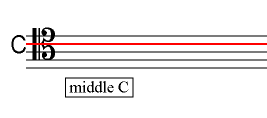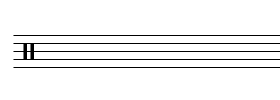|
Soprano & Mezzo-Soprano Clefs
::

|
Key words:
soprano clef
mezzo-soprano clef |
| 1 |
Soprano & Mezzo-Soprano Clefs
soprano clef, chiave di soprano (Italian f.), Sopranschlüssel (German m.), Diskantschlüssel (German m.), clé d'ut 1re (French f.), clef d'ut 1re (French f.), clave de do en primera (Spanish f.), clave de soprano (Spanish f.)
mezzo-soprano clef, chiave di mezzosoprano (Italian f.), Mezzosopranschlüssel (German m.), clé d'ut 2e (French f.), clef d'ut 2e (French f.), clé de mezzo-soprano (French f.), clef de mezzo-soprano (French f.), clave de do en segunda (Spanish f.), clave de mezzosoprano (Spanish f.)
In lesson 1 we have already described the treble or G3 clef, the bass or F4 clef and the alto or C3 clef.  The treble clef marks the G above middle C on the second line from the bottom of the five line stave, the alto clef marks middle C as the centre line on the five line stave, and the bass clef marks the F below middle C as the second line from the top of the five line stave. Notation in any field should be intuitive, clear and easy to follow. As we have already noted, when the musical line goes above or below the five lines of the stave we use leger lines to mark their pitch. It is easy enough to read at speed one or two leger lines but the performer is prone to greater error the further they move away from the five-line stave. Also, the greater the space taken by each musical line to accommodate large numbers of leger lines the more inefficient in terms of space the notation becomes. The introduction of additional clef signs allowed composers to set the music mainly within the five lines and four spaces of a stave. Changes of clef within the musical line could also accommodate passages that might otherwise call for a lot of leger lines. Vocal lines, in particular, while narrow in range, were more economically notated by using special clefs. We have already met the alto clef which is a C clef (i.e. a clef that sets the note middle C). It was used formerly for the alto voice but today it is most commonly found in music for the viola. The soprano or C1 clef, setting middle C on the bottom line of the five line stave, and the mezzo-soprano or C2 clef, setting middle C on the second from the bottom line of the five line stave, were two other 'vocal' clefs.
 
|
|
|
Tenor Clef
::

|
Key word:
tenor clefs |
| 1 |
Tenor Clef
tenor clef, chiave di tenore (Italian f.), Tenorschlüssel (German m.), clé de ténor (French f.), clef de ténor (French f.), clé d'ut 4e (French f.), clef d'ut 4e (French f.), clave de do en cuarta (Spanish f.), clave de tenor (Spanish f.)
The tenor or C4 clef is used to avoid excessive leger lines when notating very high passages for instruments that normally have their parts written in bass clef. The tenor clef was employed for the tenor voice, although today it is more commonly found in music for the larger tenor and bass viols, some brass instruments (e.g. tenor trombone) and when playing higher notes on the violoncello or bass. The clef is also required for playing much of the bassoon repertoire (thanks to Christopher Rosevear for e-mailing us about this). In this clef middle C is placed on the second line from the top of the five line stave. 
There is another tenor clef found particularly in some choral music. This is a G3 clef which has a small figure 8 placed below it indicating that the notes sound one octave lower than they are written. So the note on the second space from the top of the staff sounds as middle C although it appears to be written as the C one octave higher. This clef is known as the tenor G clef or vocal tenor clef (see 'octave clefs' below).
A reader, Steven Brawer, has drawn our attention to the use of the vocal tenor clef (1-octave-lower G clef), not only in the score of Bizet's La Boheme, but also 'routinely used in the critical editions of Rossini operas (published by the Fondazione Rossini) for the solo tenors and choral tenors.'
A third tenor clef is found in some nineteenth century arrangements of religious music for male chorus where the staff on which the two top voices are written is a C clef showing middle C on the second space from the top of the staff. The part is otherwise identical to the way it would have been written using the tenor G clef mentioned in the paragraph immediately above.

from The Male Chorus composed and arranged by Ira D. Sankey and Geo. C. Stebbins
"for use in Gospel Meetings, Christian Associations, and other Religious Services"
[image provided by Dick Adams]
|
|
|
Baritone & Subbass Clefs
::

|
Key words:
baritone clef
subbass clefs |
| 1 |
Baritone C, Baritone F & Subbass Clefs
baritone F clef, chiave di baritono (Italian f.), Baritonschlüssel (German m.), clé de fa troisième ligne (French f.), clef de fa troisième ligne (French f.), clé de fa 3e (French f.), clef de fa 3e (French f.), clave de fa en tercera (Spanish f.), clave de barítono (Spanish f.)
subbass clef, contrabass clef, chiave di basso profondo (Italian f.), Subbassschlüssel (German m.), clé de fa 5e, (French f.), clef de fa 5e, (French f.), clave de fa en quinta (Spanish f.)
The bass or F4 clef, an F clef, also has two variants called the baritone, or F3, and subbass, or F5 clefs. The subbass clef is sometimes called the contrabass clef. The baritone clef sets F below middle C on the 3rd line of a five line stave, while the subbass clef sets the F below middle C on the 5th line of the five line stave.  
There is an alternative baritone (or C5) clef employing the C clef placed on the top line of the staff.
[my thanks to Bennette Harris for spotting an earlier error, now corrected]
baritone C clef, chiave di baritono (Italian f.), Baritonschlüssel (German m.), clé d'ut cinquième ligne (French f.), clef d'ut cinquième ligne (French f.), clé d'ut 5e (French f.), clef d'ut 5e (French f.), clave de do en quinta (Spanish f.), clave de barítono (Spanish f.)

[my thanks to Bennette Harris for spotting an error in this section which has been corrected]
|
|
|
French Violin Clef
::

|
Key word:
french violin clef |
| 1 |
French Violin Clef
French violin clef, chiave di violino francese (Italian f.), französische Violinschlüssel (German m.), clé de sol 1re (French f.), clef de sol 1re (French f.), clave de sol en primera (Spanish f.), clave de violín francés (Spanish f.)
In the seventeenth and eighteenth centuries, a special clef was used for violin music, particularly that published in France. For this reason it is known as the French violin clef, French clef or G1 clef, although it was more commonly used for flute music. Being a G clef rather than a C clef, it sets the position of the G above middle C - in this case, on the bottom line of the five line stave. 
|
|
|
Octave Clefs
::

|
Key word:
octave clefs |
| 1 |
Octave Clefs
octave clef, chiave di trasposizione all'ottavo (Italian f.), Oktavierende Schlüssel (German m.), clé de octaviée (French f.), clef de octaviée (French f.), clave de transposiciones de octava (Spanish f.), clave de octavas (Spanish f.)
Even with the freedom to move C, G and even F clefs around on the five line stave, you will find occasions when the musical line is still too high or too low to fit neatly within a five line stave. One way of overcoming this problem is to move the musical line up or down an octave. The music is read as though at one octave but sounds either an octave higher (in which case the figure 8 is placed above the clef sign) or an octave lower (in which case the figure 8 is placed below the clef sign) than it is written. If the number 15 appears in place of 8 the transposition will be of two octaves. The 8 and 15are called the octave markers. The transpositions can use any of the three clef signs (the C, F and G), placed in any position on the stave. We have illustrated a number of the more common octave clefs below.
 |
 |  |  |  |  |  |
octave up G clef
| octave down G clef
vocal tenor clef | octave down
double treble clef | octave up F clef | octave down F clef | two octave up G clef | two octave up F clef |
It should be mentioned that while the use of these kind of clef signs is 'good practice', many editions ignore the additional figure 8 or 15 and use the plain sign without the figure which is then 'understood'.
|
|
|
Indefinite Pitch Clef
::

|
Key word:
indefinite pitch clefs |
| 1 |
Indefinite Pitch Clef
indefinite pitch clef, neutral clef, rhythm clef, percussion clef, chiave neutra (Italian f.), Schlagzeugschlüssel (German m.), clé neutre (French f.), clef neutre (French f.), clave neutral (Spanish f.), clave para percusión (Spanish f.)
Where the pitch of notes is indeterminate as with untuned percussion special clef signs are used. We illustrate them below. They are also called rhythm clefs or percussion clefs.   With percussion writing you will find composers using staves with anything from one to five lines. Single lines will refer to a named individual percussion instrument while multiple line staves will assign specific instruments to various lines which makes it easier for percussionists to play many instruments at the same time, for example, drummers playing on drum kits which include cymbals, side drums and bass drum, all in use at the same time.
|
|
|
Summary of Clef Signs
::

|
Key word:
clef signs |
| 1 |
Summary of Clef Signs
We summarise below all the primary clefs we have introduced earlier.


G-clef (e.g. treble clef) marks G above middle C also shown with a red line ----
C-clef (e.g. alto clef) marks middle C also shown with a blue line ----
F-clef (e.g. bass clef) marks F below middle C also shown with a green line ----
Mark Pfannschmidt has pointed out that the clef signs can be ordered also by the pitch of the note on the middle line, the highest first, the lowest last.
French violin : Treble : Soprano : Mezzo-soprano : Alto : Tenor : Baritone C clef/Baritone F clef : Bass : Contrabass/Subbass
For more information on the use of clefs signs please refer to Chart of Sounding Range and Clefs Used.
|
|
 :: next lesson :: next lesson
| |
 :: next lesson
:: next lesson